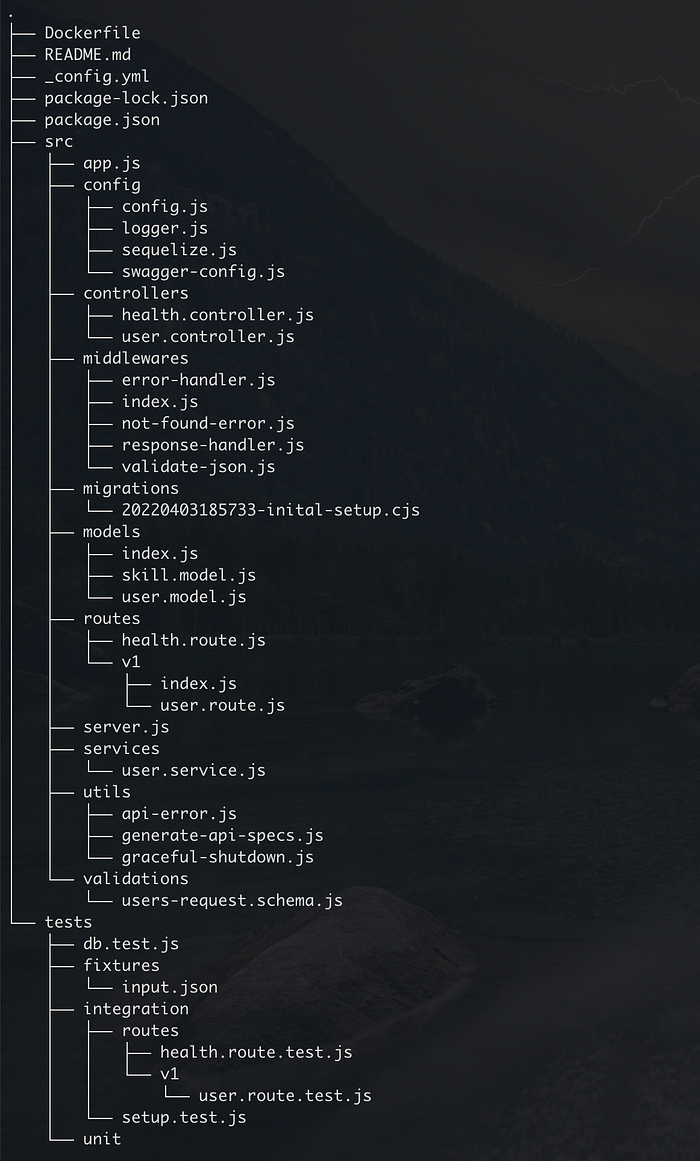Node.js Express Sequelize Boilerplate: A Comprehensive Guide to the Directory Structure

Welcome to an engaging blog focused on building a robust and efficient Node.js RESTful service using Express, PostgreSQL, and Sequelize.
This blog will explore the fundamental concepts, techniques, and tools necessary to build a high-performing Node.js service. We will begin by laying the foundation for our RESTful service, covering topics such as setting up Express as our web framework, integrating PostgreSQL as the database, and leveraging Sequelize as our ORM for seamless database interactions.
Get ready to embark on an exciting journey as we kick off this blog series with the first instalment focusing on creating a comprehensive boilerplate structure for a Node.js RESTful service using Express, PostgreSQL, and Sequelize.

Let’s start
Finding or creating a solid baseline repository structure was time-consuming and challenging when starting work on a new backend service. I struggled to locate proper resources, to begin with, leading me to create my own boilerplate code based on my learnings.
In this blog post, I aim to share and explain this boilerplate code structure to the best of my abilities, in the hope that it can assist others facing similar challenges.
Why folder structure is important?
- Organization and maintainability: A well-defined folder structure keeps your codebase organized and makes it easier to manage and locate files related to specific functionalities or modules.
- Code readability and understanding: A consistent folder structure enhances code readability and helps developers understand the architecture of the service, making it easier to navigate and locate relevant files.
- Scalability and modularity: A well-thought-out folder structure supports the scalability and modularity of your service, allowing for easy addition of new features or modules without disrupting the existing codebase.
- Reusability and code sharing: A logical folder structure promotes code reusability and sharing by providing a dedicated location for reusable components, utilities, or middleware that can be easily imported and utilized across different parts of the service.
- Testing and debugging: A well-structured folder layout aids in organizing test files and resources, making it simpler to write and run tests against specific modules or functionalities. It also helps identify relevant files and their dependencies during debugging.
- Collaboration and onboarding: A consistent folder structure promotes collaboration and facilitates onboarding of new team members by reducing confusion and enabling faster adaptation to the codebase. It provides a clear project layout that helps new developers find their way around the service.
Directory Structure
Here is a depiction of the initial directory structure:

src
The source directory contains the main application code.
- app.js: The entry point of the application that initializes and starts the server.
- server.js: Sets up and starts the Node.js server.
config
This directory holds configuration files for various aspects of the application.
controllers
Contains controller files that handle specific business logic for different routes.
middlewares
Holds middleware files responsible for handling specific tasks during request processing. Like, error-handler, generic response handler.
migrations
Contains database migration files that manage changes to the database schema. These files are generated via sequelize migration functionality.
models
Holds model files that define the database schema and interact with the database using Sequelize.
routes
Contains route files that define the API routes and their associated controller functions. These can include version based nested sub-directories and routes.
services
Contains service files that encapsulate complex business logic and interact with the models.
utils
Holds utility files that provide common functionalities used throughout the application. Like, graceful shutdown, etc.
validations
Contains validation schema files for request data validation.
tests
To ensure simplicity and easy navigation, we maintain the same file structure as the src directory. Additionally, we include a fixtures directory specifically designed to store test data required for executing tests.
Summary
This well-structured directory layout promotes code maintainability, scalability, and readability. By following this structure, developers can easily navigate the codebase, locate relevant files, and efficiently build and enhance the Node.js application.
Conclusion
In conclusion, the main emphasis of this article was on creating a solid foundation for Node.js services by implementing a boilerplate structure. The utilization of this boilerplate significantly minimizes the time and effort typically required to search for and construct the fundamental folder structure when starting a new service. Consequently, developers can allocate more resources and concentrate on crafting the essential business logic that is crucial for attaining the desired functionality. This streamlined approach enhances efficiency and allows for a more focused and productive development process.
“Thank you for reading this blog on creating a solid foundation for Node.js services. We hope you found the information helpful in streamlining your development process.”
The source code referred to in this article is available at the following GitHub repository: node-pg-sequelize-boilerplate.

